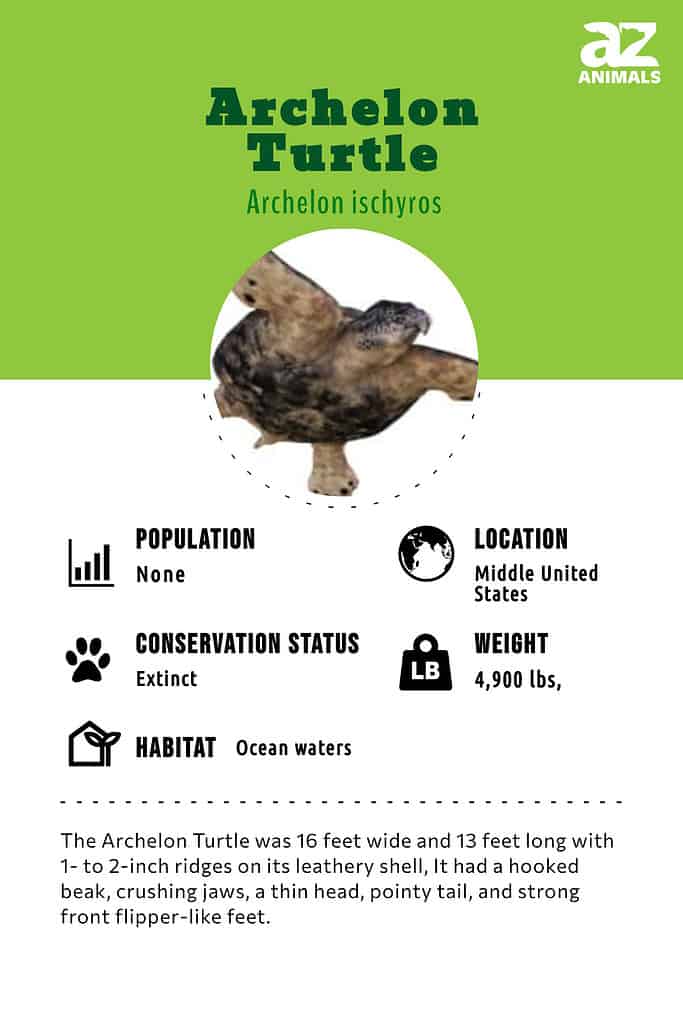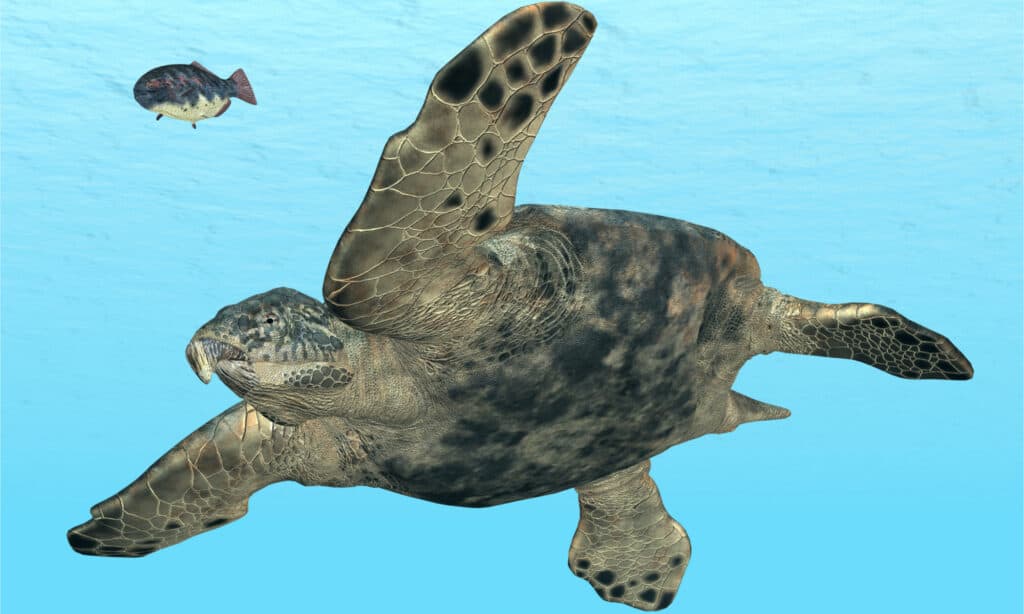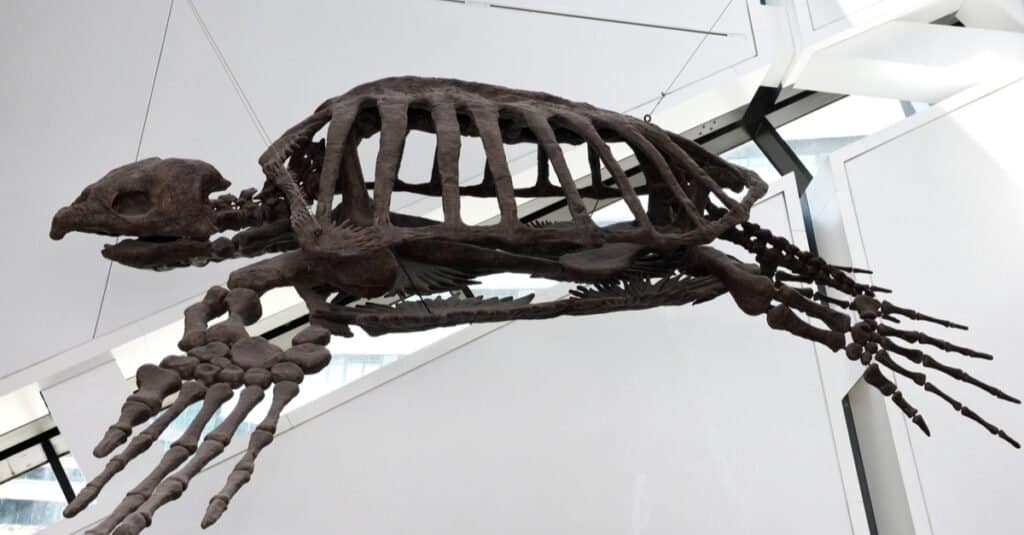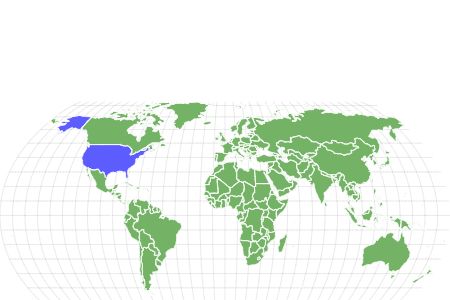Archelon Turtle
Archelons are the largest turtles to have ever lived in the world
Advertisement
Archelon Turtle Scientific Classification
- Kingdom
- Animalia
Read our Complete Guide to Classification of Animals.
Archelon Turtle Conservation Status
Archelon Turtle Facts
- Prey
- Mollusks, jellyfish, and crustaceans
- Fun Fact
- Archelons are the largest turtles to have ever lived in the world
- Biggest Threat
- Climate change
- Most Distinctive Feature
- A hooked beak like a parrot with crushing jaws
- Distinctive Feature
- Incredibly strong front feet that were able to pull its mass through the water like paddles
- Nesting Location
- On the beach
View all of the Archelon Turtle images!

Scientific Name and Classification
The creature’s genus name of Archelon comes from Ancient Greek arkhe, meaning “first” or “early,” and chelone, meaning “turtle.” Its species name of ischyros is also Greek, meaning “mighty” or “powerful.”
This turtle is from the Class Reptilia, the Order Testudines, the Suborder Cryptodira, and the extinct Family Protostegidae. Its genus and species name is Archelon ischyros. Although it looks like other sea turtles at face value, Archelon does not share ancestry with any other sea turtle, living or extinct. Its ancestry is unknown except through the connections to its Order and Suborder, but the Family Protostegidae diverged onto a path of its own.
Description and Size

The Archelon turtle measured up to 13.1 feet from nose to tail and 16 feet wide from one flipper tip to the other.
©Michael Rosskothen/Shutterstock.com
The Archelon turtle had a body mass of 4,900 pounds. It measured up to 13.1 feet from nose to tail and 16 feet wide from one flipper tip to the other. Although its shell looked much like that of modern sea turtles, it was lighter and more leathery than hardened, like the leatherback sea turtle.
It is also believed that this shell had 1-inch to 2-inch ridges on it. The marine animal had a hooked beak like a parrot with crushing jaws and incredibly strong front feet that were able to pull its mass through the water like paddles.
The Archelon turtle’s description and size details include:
- 4900 lb. weight
- 16 feet wide
- 13 feet long
- 1- to 2-inch ridges on its leathery shell
- Hooked beak
- Crushing jaws
- Thin head
- Pointy tail
- Strong front “flipper-like” feet
The turtle likely fed on mollusks, jellyfish, and crustaceans found on the seafloor. Its primary predators were prehistoric sharks and the Mosasaur.
Although there are many gaps in scientific knowledge about the Archelon’s mating and nesting habits, we do know that they nested on the beach. Like other sea turtles, they would come out of the water at night and lay eggs beneath the sand’s surface.

Archelon turtles had massive feet that they used like flippers to pull their bulky bodies through the water.
©Michael Rosskothen/Shutterstock.com
Diet
The Archelon turtle was a carnivore that fed mostly on crustaceans, mollusks, and jellyfish. This diet is essentially the same as many sea turtles today. It was able to find these foods at the water’s surface. This meant it could eat well without having to dive down to the bottom, but it could go that deep and use its paddle-like feet to pull itself through the sea floor.
Habitat
The Archelon lived during the Late Cretaceous period 100 million to 66 million years ago in the Western Interior Seaway that once cut through the middle of North America. The prehistoric animal’s fossil was found in 1895 in the Pierre Shale geological formation of South Dakota, which was covered by this sea 80.5 million years ago. Since that time, fossils of the sea turtle have also been found in Wyoming and North Dakota. A specimen from South Dakota is believed to have lived to be about 100 years of age.
Another specimen was found in the Pierre Shale geological formation in 1970. This turtle measured 16 feet wide, from one flipper’s tip to the other. It was 13.1 feet long. Because the Archelon is larger than Protostega gigas (9.8 feet long) and Stupendemys (11 feet long), it is now identified as the world’s biggest turtle in history.
Threats and Predators
The primary predators of Archelon sea turtles were prehistoric sharks and the Mosasaur, a giant sea creature that had an alligator-like head and jaws and a shark-like body.
However, it is believed the giant turtles became extinct because of climate change, the associated cooling climate, and the shrinking of the Western Interior Seaway. Increasing predation on eggs and hatchlings also likely played a role in the creature’s end.
Discoveries and Fossils

Fossils like this one have been found in North and South Dakota, Wyoming, and Kansas.
©Reimar/Shutterstock.com
The Archelon sea turtle was first discovered by American paleontologist George Reber Wieland in 1895. He found the holotype specimen – the first-ever fossil of the species – in the Pierre Shale geological formation of South Dakota. Wieland found the bones on the shore of the Cheyenne River in Custer County. The specimen he discovered was missing its skull. But in 1897, someone else found a fossilized skull of the turtle in the same area.
In 1902, another complete specimen was found on the Cheyenne River. The most recent discoveries of Archelon skeletons occurred in South Dakota in 1992 and North Dakota in 2002. The 1992 discovery was the largest specimen found to date. Nicknamed Brigitta, this fossilized Archelon was uncovered in Oglala Lakota County, South Dakota. It is now housed in the Vienna Natural History Museum.
Extinction
The Archelon is believed to have died out at the end of the Late Cretaceous period. This means it no longer existed after 66 million years ago. Scientists believe it became extinct because of the effects of climate change. These changes were, specifically, cooling temperatures and reduction of the turtle’s home waters, the Western Interior Seaway. Land-based mammals also fed on the turtles’ eggs and hatchlings on the beaches of this seaway. That predation increased over time and led to fewer of the turtles surviving into adulthood.
Similar Animals
There were several prehistoric animals similar to the Archelon turtle, although none were as large as this sea-dwelling giant.
Similar dinosaurs to the Archelon turtle include:
- Protostega gigas – Extinct sea turtles much like Archelon turtles, but much smaller at 8.9 feet long. These turtles swam the Western Interior Seaway of North America and were first discovered in 1871 in Kansas.
- Microstega copei – Another extinct sea turtle from the Late Cretaceous period, first described by George Reber Wieland in 1909 after discovery in Kansas.
- Notochelone – First discovered by Richard Lydekker in 1889, this sea turtle was the most common reptile in the oceans around Queensland, Australia, during the Early Cretaceous period. It lived about 100 million years ago, was much smaller than Archelon ,and is extinct.
Archelon Turtle FAQs (Frequently Asked Questions)
When did the Archelon turtle live?
The Archelon turtle lived during the Late Cretaceous period from 100 million to 66 million years ago. It is the biggest turtle to have ever lived on Earth. The first fossils of this marine giant were found in 1895 in South Dakota by an American paleontologist.
How big was the Archelon turtle?
The biggest specimen of the Archelon turtle is now housed in the Vienna Natural History Museum in Vienna, Austria. It measures 13.1 feet long and 16 feet wide, from the tip of one front flipper to the other. The Archelon weighed as much as two tons, 4900 lbs.
Why did the Archelon turtle go extinct?
The Archelon turtle had gigantic predators in the water, including prehistoric sharks and the Mosasaur. But these were not the reasons why Archelons became extinct. Instead, they died out because of climate changes and predation of their young. The climate changes included cooling temperatures and reduction in the size of the Western Interior Sea where they lived. Predation of their young involved other mammals eating their eggs and hatchlings.
What did Archelon turtles eat?
Archelon turtles were gigantic in size and had equally gigantic appetites. They fed mostly on prehistoric mollusks, crustaceans and jellyfish found in the Western Interior Sea habitat. These food options were abundant at the surface of the water. So, the turtles could eat their fill without diving into deeper water or skimming the sea floor.
What ate Archelon turtles?
The primary predators of Archelon turtles included prehistoric sharks and the Mosasaur of the Late Cretaceous period. Luckily for the giant sea turtle, there were no megalodon sharks yet. But one subspecies of Mosasaur, Mosasaurus hoffmannii, measured up to 56 feet long! This intimidating sea creature looked like a cross between an alligator and a shark, with very long, wide-opening jaws with many sharp teeth.
Thank you for reading! Have some feedback for us? Contact the AZ Animals editorial team.
Sources
- Wikipedia / Accessed May 17, 2022
- Britannica / Accessed May 17, 2022
- Sea Turtle Space Coast / Accessed May 17, 2022
- Dino Animals / Accessed May 17, 2022
- New Dinosaurs / Accessed May 17, 2022
- Prehistoric Wildlife / Accessed May 17, 2022
- Archelon / Accessed May 17, 2022
- Prehistoric Earth a Natural History / Accessed May 17, 2022
- Thought Co. / Accessed May 17, 2022
- BHIGR / Accessed May 17, 2022

















